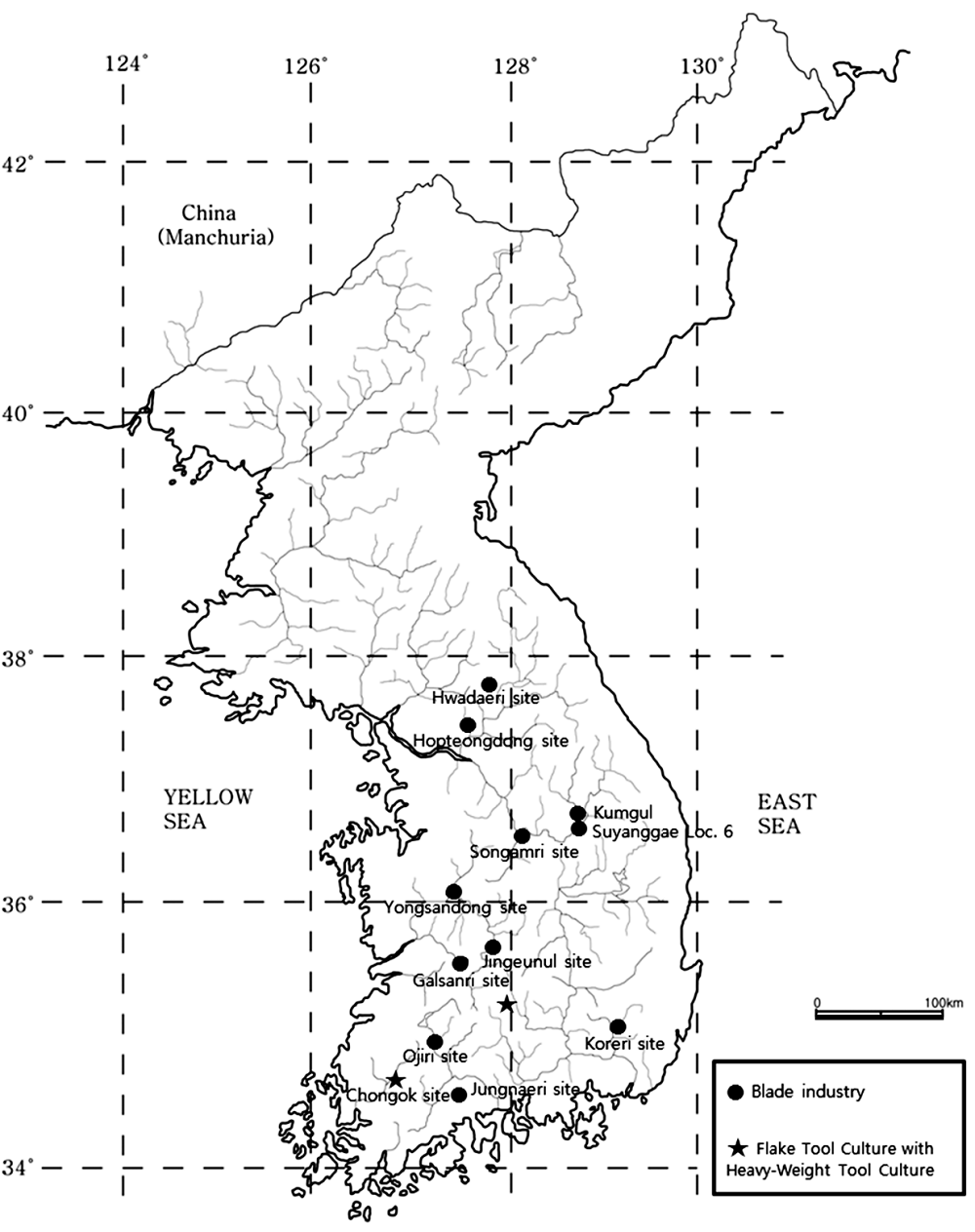

收稿日期: 2018-05-08
修回日期: 2019-01-02
网络出版日期: 2020-09-10
Chronology and characteristics of the Upper Palaeolithic blade tool industry in Korea
Received date: 2018-05-08
Revised date: 2019-01-02
Online published: 2020-09-10
本文介绍了韩国石叶组合的区域特征,并在近期研究的基础上对人类向朝鲜半岛的迁移进行了概述。除了西伯利亚的阿尔泰地区等及华北的水洞沟外,石叶组合在东亚地区的旧石器遗址中十分罕见。1990年底,韩国密阳市的Koreri遗址发现了一个典型的石叶石器工业遗存。在过去的十年间,韩国还发现了数个重要的遗址。朝鲜半岛的砾石石器工业一直持续到旧石器时代晚期的较早阶段,而在大约40kaBP,朝鲜半岛出现了石叶组合。在这些典型的石叶地点中,未发现大多数种类的重型工具。这些特征表明,朝鲜半岛的石叶工业可能是人类迁移的结果。目前还没有证据表明韩国的石叶工具工业在25~10 kaBP被细石叶工业取代,相反,这两种文化可能是由移居朝鲜半岛的不同人群产生的,在细石叶的使用用群体迅速扩散到整个朝鲜半岛时,石叶工业仍然延续,在25~15 kaBP的时间里与细石叶工业并存。

LEE Heonjong , LEE Sangseok . 韩国旧石器时代晚期石叶工业的年代与特征[J]. 人类学学报, 2019 , 38(03) : 373 -388 . DOI: 10.16359/j.cnki.cn11-1963/q.2019.0037
This article describes the regional characteristics of blade tool assemblages in Korea and presents a general overview of human migrations into the Korean Peninsula based on recent research. Paleolithic sites with blade tool assemblages are rare in East Asia except for the Altai and other regions of Siberia, and Shuidonggou in North China. At the end of 1990, the remains of a typical blade tool industry were found at the Koreri site, Milyang City. For the last ten years, several important sites have been found in South Korea. Around 40 kaBP, blade tool assemblages appeared in the Korean Peninsula while the pebble tool tradition still existed in the early Upper Paleolithic. Most heavy-weight tools disappeared at typical blade tool sites. These consistent characteristics demonstrate that the blade tool industry was probably the result of migration. There is no evidence that a microblade industry(25~10 kaBP) replaced the blade tool industry in Korea. Rather, these two cultures were probably produced by different populations who migrated into the Korean peninsula. When groups using microblades rapidly spread throughout the entire Korean peninsula, the blade tool industry still coexisted from ca. 25 to 15 kaBP.

Key words: Blade; Upper Palaeolithic; Chronology; Characteristics; Korea
| [1] | Lee HJ. A study the conservative character and persistence of the pebble tool tradition in Korea, Hanguk Sanggosa Hakbo, 2002,38:27-52(In Korean) |
| [2] | Sohn BK. Report of site excavation research in Dodam-ri, Danyang-1983-84 year. Chungju Dam Sumoljigu. Report of site excavation research. Chungbuk University Museum, 1984: 213(In Korean) |
| [3] | Sohn BK. Report of site excavation research in Dodam-ri, Danyang -1985 year-Chungju Dam Sumoljigu Report of site excavation research. Chungbuk University Museum, 1985, 253pp(In Korean) |
| [4] | Lee HJ. Chronology of Upper Paleolithic in Korean Peninsula. 3rd international symposium: Suyanggae and her neighbors, 1998, 87-104 |
| [5] | Seo YN, Kim HJ, Jang YJ. Upper Paleolithic culture of Goryeri site, in Milyang-si, Kyengnam province. Youngnam Jibang Guseokki Munhwa, 1999, 47-64(in Korean) |
| [6] | Lee GK, Choi MN, Kim EJ. Soonchon jungnae-ri site, Korea, 2000. 1-319(in Korean) |
| [7] | Jang YJ. The study of core from Milyang Koreri site in Paleolithic age. 2001, 1-138(in Korean) |
| [8] | Jang YJ. Core reduction technology during the Upper Palaeolithic focusing on the Goryeri Collection Milyang Korea. Hanguk Guseokgi Hakbo, 2001,4:43-64(in Korean) |
| [9] | Lee GK. The Jingeuneul Upper Palaeolithic site in Jinan County of submerged area around the Yongdam Dam and its significance. Honam Gogohakbo, 2004,19:5-23(in Korean) |
| [10] | Cha MA. Study on the Spatial Distribution of Artefacts of the Upper Palaeolithic from Jingeunul Site in Jinan County Korea. 2007, 1-88(in Korean) |
| [11] | Lee GK. The cultural continuities and innovations in the Korean Upper Palaeolithic culture along with its interactions. Honam Gogohakbo, 2012,41:5-34(in Korean) |
| [12] | Lee HJ, No SH, Lee HY. Report on the excavation of Dangga Site, Chongokri site, Naju. 2004, 1-371(in Korean) |
| [13] | Lee HJ. Preliminary consideration of complexity of culture lines of the Upper Paleolithic in Korea. 15th international symposium: Suyanggae and her neighbors, 2010, 197-203 |
| [14] | Hong MY, Kim JH. Hopyeong-dong Paleolithic site(Namyangju, Gyeonggi Province, Korea) II. 2008, 1-850(in Korean) |
| [15] | Choi BK, Yu HJ. The Hwadae-ri Shimteo Paleolithic Site in Pocheon-si, Korea. 2005. 1-149(in Korean) |
| [16] | Lee HJ. Study of comparison of microblade core technical system of Upper Paleolithic in Northeast Asia. Dongbuka Mumhwa Yeongu, 2008,16:83-108(in Korean). |
| [17] | Institute of Korean Prehistory. Report on the Excavation of Songam-ri Waesil Site, Chungju. 2014, 1-331(In Korean) |
| [18] | Honam Cultural Property Research Center. Galsanri Site, Wanju. 2014, 1-476(In Korean) |
| [19] | Lee HJ, Lee SS. The characteristics and changes of blade tool techniques in Korea. 19th international symposium: Suyanggae and her neighbors in Poland. 2014, 103-112 |
| [20] | Jang YJ. Study on techniques and chronology of Upper Paleolithic age in Korea. 2007, 1-265(in Korean) |
| [21] | Lee HJ, Lee SS. The study of blade tool culture in Korea. 18th international symposium: Suyanggae and her neighbors, 2013, 109-114 |
| [22] | Lee HJ, Lee SS. Preliminary Study of characteristics and its change of blade core technical system in Korea. Hanguk Guseokgi Hakbo, 2014,29:21-48(in Korean) |
| [23] | Central institute of Cultural Heritage. The Paleolithic Site at Yongsandong of Daejeon. 2007, 1-265(in Korean) |
| [24] | Lee HJ. Correlation of chronology and techno-typological character of Upper Paleolithic in Korea, Hanguk Sanggosa Hakbo, 2004,44:5-22(in Korean) |
| [25] | Derevianko AP. Formation of blade industries in Eastern Asia. Archaeology. Ethnology & Anthropology of Eurasia, 2005,4:2-30 |
| [26] | Liu DC, Wang XL, Gao X, et al. Progress in the stratigraphy and geochronology of the Shuidonggou site, Ningxia, North China. Chinese Science Bulletin, 2009,54:3880-3886 |
| [27] | Madson DB, Oviatt CG, Zhu Y, et al. The early appearance and possible last persistence of Shuidonggou core-and-blade technology: implications for the spread of anatomically modern humans in Northeast Asia. Abstract of international symposium in commemoration of the 90th anniversary of the discovery of Shuidonggou, the 6th annual meeting of Asian Paleolithic Association and the 18th symposium of Suyanggae and Her Neighbors. 2013: 58-59 |
| [28] | Nian X, Gao X, Zhou L. Chronological studies of Shuidonggou(SDG) Locality 1 and their significance for archaeology, Abstract of international symposium in commemoration of the 90th anniversary of the discovery of Shuidonggou, the 6th annual meeting of Asian Paleolithic Association and the 18th symposium of Suyanggae and Her Neighbors. 2013, 66-67 |
/
| 〈 |
|
〉 |